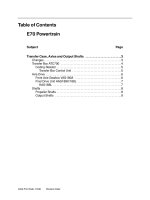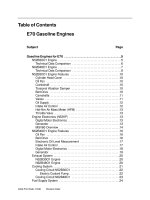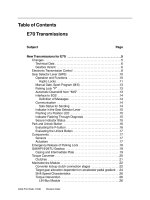C1016 02
Bạn đang xem bản rút gọn của tài liệu. Xem và tải ngay bản đầy đủ của tài liệu tại đây (30.11 KB, 3 trang )
Designation: C 1016 – 02
Standard Test Method for
Determination of Water Absorption of Sealant Backing
(Joint Filler) Material1
This standard is issued under the fixed designation C 1016; the number immediately following the designation indicates the year of
original adoption or, in the case of revision, the year of last revision. A number in parentheses indicates the year of last reapproval. A
superscript epsilon (e) indicates an editorial change since the last revision or reapproval.
4.2 Procedure A measures the maximum amount of water
that can enter the backing. Procedure B measures the amount
of water that can enter the backing with the backing cut ends
sealed.
1. Scope
1.1 This test method covers a laboratory procedure for
determining the water absorption characteristics of sealant
backing and joint filler materials, hereinafter referred to as
backing.
1.2 The values stated in SI units are to be regarded as the
standard. The inch-pound units in parentheses are for information only.
1.3 The committee with jurisdiction over this standard is not
aware of any comparable standards published by other ASTM
committees or other organizations.
1.4 This standard does not purport to address all of the
safety concerns, if any, associated with its use. It is the
responsibility of the user of this standard to establish appropriate safety and health practices and determine the applicability of regulatory limitations prior to use.
5. Significance and Use
5.1 This test method determines the amount of water absorbed by a backing material. Water absorption by the backing
may affect sealant performance.
5.2 This test method is also useful when designating proper
storage of back up material and in determining appropriate
precautions when using backing materials.
5.3 The specifier, using this test method, can exercise
judgment in the selection of backing materials based on water
absorption characteristics.
6. Apparatus
6.1 Balance, sensitive to 0.1 g (0.004 oz).
6.2 Rule, steel, graduated to 1.0 mm (;1⁄16 in.).
6.3 Shallow Pan for Water, at least 50 mm (2 in.) deep and
350 mm (14 in.) long.
6.4 Paraffın Wax. 4
2. Referenced Documents
2.1 ASTM Standards:
C 717 Terminology of Building Seals and Sealants2
E 691 Practice for Conducting an Interlaboratory Study to
Determine the Precision of a Test Method3
7. Sampling
7.1 Take samples from manufactured product. The number
of samples for each lot shall be agreed upon between the
purchaser and the seller. A sample shall consist of three test
specimens.
7.2 Sample selection is important, therefore, the sample
should be representative of typical backing production. Care
should be exercised in choosing samples that have not been
damaged by inappropriate storage or handling.
7.3 Samples should be of uniform shape for their length to
enable accurate calculation of volume.
3. Terminology
3.1 Definitions—Refer to Terminology C 717 for the following terms used in this test method: joint filler, sealant, and
sealant backing.
4. Summary of Test Method
4.1 The mass of three measured specimens of backing is
determined. The specimens are then placed in room temperature water for 24 h after which the specimens are removed from
the water and their mass measured. The change in mass is
calculated, and the result is expressed as a change in mass per
unit of volume.
1
This test method is under jurisdiction of ASTM Committee C24 on Building
Seals and Sealants and is the direct responsibility of Subcommittee C24.20 on
General Test Methods.
Current edition approved Jan. 10, 2002. Published March 2002. Originally
published as C 1016 – 84. Last previous edition C 1016 – 94a.
2
Annual Book of ASTM Standards, Vol 04.07.
3
Annual Book of ASTM Standards, Vol 14.02.
4
Paraffin wax, manufactured by Thomas Scientific, 99 High Hills Rd., Swedesboro, NJ 08085, or equal, has been found suitable for this purpose.
Copyright © ASTM International, 100 Barr Harbor Drive, PO Box C700, West Conshohocken, PA 19428-2959, United States.
1
C 1016 – 02
10.2.6 After immersion for 24 h, remove the specimen by
picking it up 3 in. (75 mm) from the ends and place it
immediately on the weighing platform. Do not press or squeeze
the specimen. Within the next 1 min, record the mass of the
specimen to the nearest 0.1 g (0.004 oz).
10.2.6.1 The weighing platform should be large enough to
support the entire specimen and serve as a tray to catch any
water that may leave the specimen during mass determination.
8. Test Specimens
8.1 A test specimen is a piece of backing 300 6 5 mm (12
6 0.25 in.) in length. Ideally the cross-sectional backing area
should be from 2 to 3 cm2 (0.3 to 0.5 in.2). Cut three test
specimens from each sample.
9. Conditioning
9.1 Condition the test specimens at 23 6 2°C (73 6 3°F)
and 50 6 5 % relative humidity for a minimum of 24 h prior
to testing, provided the specimens feel and appear dry. Specimens that appear damp should be dried in accordance with the
manufacturer’s recommendations before the 24 h conditioning
period starts.
11. Calculation
11.1 Calculate each specimen’s dry cross-sectional area (A0)
using the appropriate formula for the geometry of the crosssection shape.
11.2 Calculate the dry, original volume, (V0), as follows:
10. Procedure
10.1 Procedure A:
10.1.1 Measure the mass of each conditioned specimen to
the nearest 0.1 g (0.004 oz) and record.
10.1.2 Measure and record the length of each specimen to
the nearest 1 mm (1⁄16 in.).
10.1.3 Measure and record the appropriate end dimensions
of each specimen to the nearest 1 mm (1⁄16 in.), to permit a
cross-sectional area calculation.
10.1.3.1 The procedures in 10.1.2 and 10.1.3 are critical to
the precision and bias of the test. Care is required to obtain
accurate measurements.
10.1.4 Submerge the entire specimen in water in a shallow
pan. Secure the specimen so the top side in the long dimension,
is approximately 25 mm (1 in.) below surface.
10.1.5 After immersion for 24 h, remove the specimen by
picking it up 3 in. (75 mm) from the ends and place it
immediately on the weighing platform. Do not press or squeeze
the specimen. Within the next 1 min, record the mass of the
specimen. Within the next 1 min, record the mass of the
specimen to the nearest 0.1 g (0.004 oz).
10.1.5.1 The weighing platform on the balance should be
large enough to support the entire specimen and serve as a tray
to catch any water that may leave the specimen during mass
determination.
10.2 . Procedure B:
10.2.1 Measure and record the length of each specimen to
the nearest 1 mm (1⁄16 in.).
10.2.2 Measure and record the appropriate end dimensions
of each specimen to the nearest 1 mm (1⁄16 in.), to permit a
cross-sectional area calculation.
10.2.2.1 The procedures in 10.2.1 and 10.2.2 are critical to
the precision and bias of the test. Care to obtain accurate
measurements is required.
10.2.3 Dip the cut ends of the specimen to a depth of 3.0
mm (1⁄8 in.) in melted paraffin wax at 65 6 5°C, remove and let
cool. Repeat the dipping three times until the ends are
completely sealed by approximately 1 mm (1⁄16 in.) of paraffin
wax on each cut end.
10.2.4 After the wax cools, measure the mass of each
conditioned specimen to the nearest 0.1 g (0.004 oz) and
record.
10.2.5 Submerge the entire specimen in water in a shallow
pan. Secure the specimen so the top side, in the long dimension, is approximately 25 mm (1 in.) below the surface.
V 0 5 10 3 A 0
where:
V0 = original dry volume, cm3 (in.3),
A0 = cross-sectional area cm2 (in.2), and
10 = original length, cm (in.).
11.3 Calculate water absorption as a mass per unit volume
for each specimen as follows:
W5
m0 2 m1
V0
where:
W = water absorption, g/cm3 (oz/in.3),
m1 = initial mass, g (oz),
m0 = final mass, g (oz), and
V0 = initial dry volume, cm3 (in.3)
11.4 For purposes of calculation it is assumed that, at 23 6
2°C (73 6 3°F) and atmospheric pressure, 1 g (0.035 oz) of
water occupies 1 cm3 (0.061 in.3) in volume.
11.5 Calculate the sample average water absorption as
follows:
Wa 5
where:
Wa =
W1 =
W2 =
W3 =
W1 1 W2 1 W3
3
average water absorption, g/cm3 (oz/in.3),
Specimen 1 water absorption, g/cm3 (oz/in.3),
Specimen 2 water absorption, g/cm3 (oz/in.3), and
Specimen 3 water absorption, g/cm3 (oz/in.3).
12. Report
12.1 Report the following information:
12.1.1 Name and description of the tested backing material,
12.1.2 Date of receipt of the backing material,
12.1.3 Procedure A or B, and
12.1.4 Individual specimen and sample average water absorption values.
13. Precision and Bias 5
13.1 These data were developed using 1.59 cm (5⁄8 in.)
diameter closed cell, open cell, and soft-type backing material,
therefore results may vary with different diameter backing
materials.
5
2
Supporting data is available from ASTM Headquarters. Request RR:C24-1014.
C 1016 – 02
13.1.2.1 The repeatability (within a given laboratory) interval for
three materials tested by four laboratories is 0.024
3
g/cm (0.014 oz/in.3). In the future use of this test method, the
difference between two test results obtained in the same
laboratory on the same material will be expected to exceed
0.024 g/cm3 (0.014 oz/in.3) only about 5 % of the time.
13.1.2.2 The reproducibility (between given laboratories)
interval for three materials tested by four laboratories is 0.387
g/cm3 (0.217 oz/in.3). In future use of this test method, the
difference between two test results obtained in a different
laboratory on the same material will be expected to exceed
0.387 g/cm3 (0.217 oz/in.3) only about 5 % of the time.
13.1.1 Procedure A:
13.1.1.1 The repeatability (within a given laboratory) interval for three materials tested by four laboratories is 0.044
g/cm3 (0.025 oz/in.3). In future use of this test method, the
difference between two test results obtained in the same
laboratory on the same material will be expected to exceed
0.044 g/cm3 (0.025 oz/in.3) only about 5 % of the time.
13.1.1.2 The reproducibility (between given laboratories)
interval for three materials tested by four laboratories is 0.387
g/cm3 (0.222 oz/in.3). In future use of this test method, the
difference between test results obtained in a different laboratory 3on the same material will be expected to exceed 0.387
g/cm (0.222 oz/in.3) only about 5 % of the time.
13.1.2 Procedure B:
14. Keywords
14.1 sealant; sealant backing; water absorption
ASTM International takes no position respecting the validity of any patent rights asserted in connection with any item mentioned
in this standard. Users of this standard are expressly advised that determination of the validity of any such patent rights, and the risk
of infringement of such rights, are entirely their own responsibility.
This standard is subject to revision at any time by the responsible technical committee and must be reviewed every five years and
if not revised, either reapproved or withdrawn. Your comments are invited either for revision of this standard or for additional standards
and should be addressed to ASTM International Headquarters. Your comments will receive careful consideration at a meeting of the
responsible technical committee, which you may attend. If you feel that your comments have not received a fair hearing you should
make your views known to the ASTM Committee on Standards, at the address shown below.
This standard is copyrighted by ASTM International, 100 Barr Harbor Drive, PO Box C700, West Conshohocken, PA 19428-2959,
United States. Individual reprints (single or multiple copies) of this standard may be obtained by contacting ASTM at the above
address or at 610-832-9585 (phone), 610-832-9555 (fax), or (e-mail); or through the ASTM website
(www.astm.org).
3









